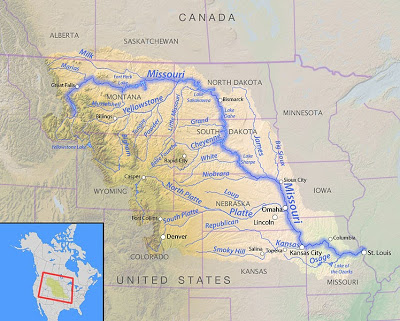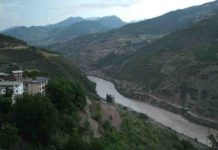
The Missouri River is the longest river in North America, longest tributary in the United States and a major waterway of the central United States. Rising in the Rocky Mountains of western Montana, the Missouri flows east and south for 2,341 miles (3,767 km) before entering the Mississippi River north of St. Louis, Missouri. The river takes drainage from a sparsely populated, semi-arid watershed of more than half a million square miles (1,300,000 km2), which includes parts of ten U.S. states and two Canadian provinces. When combined with the lower Mississippi River, it forms the world’s third longest river system.
For over 12,000 years, people have depended on the Missouri and its tributaries as a source of sustenance and transportation. More than ten major groups of Native Americans populated the watershed, most leading a nomadic lifestyle and dependent on enormous buffalo herds that once roamed through the Great Plains. The first Europeans encountered the river in the late seventeenth century, and the region passed through Spanish and French hands before finally becoming part of the United States through the Louisiana Purchase. The Missouri was long believed to be part of the Northwest Passage – a water route from the Atlantic to the Pacific – but when Lewis and Clark became the first to travel the river’s entire length, they confirmed the mythical pathway to be no more than a legend.
The Missouri was one of the main routes for the westward expansion of the United States during the 19th century. The growth of the fur trade in the early 1800s laid much of the groundwork as trappers explored the region and blazed trails. Pioneers headed west en masse beginning in the 1830s, first by covered wagon, then by the growing numbers of steamboats entering service on the river. Former Native American lands in the watershed were taken over by settlers, leading to some of the most longstanding and violent wars against indigenous peoples in American history.
During the 20th century, the Missouri River basin was extensively developed for irrigation, flood control and the generation of hydroelectric power. Fifteen dams impound the main stem of the river, with hundreds more on tributaries. Meanders have been cut and the river channelized to improve navigation, reducing its length by almost 200 miles (320 km) from pre-development times. Although the lower Missouri valley is now a populous and highly productive agricultural and industrial region, heavy development has taken its toll on wildlife and fish populations as well as water quality.
Course
Geology
Immediately before the Quaternary Ice Age, the Missouri River was likely split into three segments: an upper portion that drained northwards into Hudson Bay, and middle and lower sections that flowed eastward down the regional slope. As the Earth plunged into the Ice Age, a pre-Illinoian (or possibly the Illinoian) glaciation diverted the Missouri River southeastwards towards its present confluence with the Mississippi and caused it to integrate into a single river system that cuts across the regional slope. In western Montana, the Missouri River is thought to have once flowed north then east around the Bear Paw Mountains. Sapphires are found in some spots along the river in western Montana. Advances of the continental ice sheets diverted the river and its tributaries, causing them to pool up into large temporary lakes such as Glacial Lakes Great Falls, Musselshell and others. As the lakes rose, the water in them often spilled across adjacent local drainage divides, creating now-abandoned channels and coulees including the Shonkin Sag, 100 miles (160 km) long. When the glaciers retreated, the Missouri flowed in a new course along the south side of the Bearpaws, and the lower part of the Milk River tributary took over the original main channel.
The Missouri’s nickname, the “Big Muddy”, was inspired by its enormous loads of sediment or silt – some of the largest of any North American river. In its pre-development state, the river transported some 175–320 million short tons (193–290 million t) per year. The construction of dams and levees has drastically reduced this to 20–25 million short tons (18–23 million t) in the present day. Much of this sediment is derived from the river’s floodplain, also called the meander belt; every time the river changed course, it would erode tons of soil and rocks from its banks. However, damming and channeling the river has kept it from reaching its natural sediment sources along most of its course. Reservoirs along the Missouri trap roughly 36.4 million short tons (32.9 million t) of sediment each year. Despite this, the river still transports more than half the total silt that empties into the Gulf of Mexico; the Mississippi River Delta, formed by sediment deposits at the mouth of the Mississippi, constitutes a majority of sediments carried by the Missouri.











